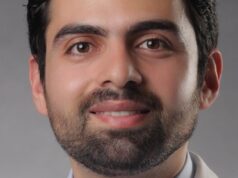
In the latter stages of 2022, the Society of NeuroInterventional Surgery (SNIS) released a position statement advocating pregnancy and parental leave policies in neurointerventional surgery, stating a belief that physicians “should not have to choose” between a fulfilling family life and their professional career. The statement came off the back of a structured literature review, published in the Journal of NeuroInterventional Surgery (JNIS), that was led by Amanda Baker (San Francisco, USA) and used survey data regarding proposed changes to reduce barriers for women and parents pursuing family life, as well as addressing concerns regarding radiation exposure.
I recently sat down—remotely—with Dr Felipe Albuquerque, JNIS editor-in-chief, who I was thrilled to hear took an interest in our recently published article on pregnancy and parental leave.1,2 He remarked that some of the barriers that females face in the field of neurointerventional surgery can be subtle. I was interested in this comment, as it made me give pause and consider: What exactly are the barriers for women interested or currently practising in this field? And, how can we, as women, better communicate to our male colleagues what is and is not contributing to the gender disparity?
I am familiar with being the only woman in a room full of men; my undergraduate studies in nuclear engineering were another example. Nearly two decades later, as a brand new neurointerventionist, I continue to be the only woman—or one of very few women—in a room full of men. At least half of medical school graduates are female3 yet, based on SNIS membership data, women likely represent less than 10% of practising neurointerventionists.4 Gender disparity in neurointerventional surgery has followed from the specialties that comprise it5—neuroradiology, neurosurgery and stroke neurology—with an even smaller percentage of females in these fields interested in pursuing neurointerventional surgery.
I have spent countless hours questioning, reading, thinking: Why are there not more women in the room? Is radiation really the major barrier for women to enter nuclear engineering and, now, neurointerventional surgery?
Radiation risks
In 1903, Marie Curie was the first woman to win the Nobel Prize in Physics for her work in radiation.6 Her story reflected the danger of radiation, which likely caused the aplastic anaemia that ultimately took her life. The reality of this is depicted by an infamous radiograph of her hand. The nuclear field has made significant strides in upholding standards for radiation workers in diagnostic and therapeutic medical fields, yet many women remain photon averse, particularly during childbearing years.
Overall, the data suggest that the cumulative dose during pregnancy remains low with the use of appropriate radiation protection equipment.7,8 Personally, this was reflected by my dosimeter during pregnancy in the second year of my neurointerventional fellowship. But what is ‘low dose’—what does this mean in terms of risk, and does that differ with respect to oncologic risk, reproductive risk or perinatal risk?
As a nuclear engineer, the short answer is that we do not know. Health risks related to radiation exposure remain based on atomic bomb survivors, and the data for the lowest doses have been theoretically extrapolated.9,10 More definitive answers have yet to be elucidated due to limitations of cofounding, bias and reverse causation in retrospective and epidemiologic studies; ethical inability to conduct prospective studies; and the gap between the damage/repair cycle in irradiated cells and in vivo reality. For now, we can rest assured that, although this topic remains controversial, substantially increased risk following low-dose radiation is unproven.11
While we have means to quantify radiation dose by wearing dosimeters, we do not have a way to measure anxiety and the realistic concerns that accompany pregnancy. The best we can do is recognise the difficulty in the unknown (i.e. risk of low doses of ionising radiation to a fetus) and mitigate risk with availability of full protective equipment, as well as allow for continued flexibility in the workplace12—particularly for our pregnant colleagues.
In Interventional Neuroradiology, Power et al4 demonstrated via a survey of nearly 300 neurointerventionists, the majority of whom were between 35 and 60 years of age, that significantly fewer women were married (63% vs 91%) or had children (42% vs 84%) compared to men. We must keep in mind that radiation concerns around childbearing may not be applicable to all women. I would argue other barriers are equally if not more pressing for women choosing this field.
A positive outlook?
Neurointerventional surgery is inherently a difficult subspecialty, requiring a lot of call, stressful procedures, and inflexible work hours. It is not typically chosen for its ‘quality-of-life’ benefits. These characteristics are unlikely to change and, if anything, may worsen in the wake of the New England Journal of Medicine trials demonstrating efficacy for thrombectomy in patients with large-core infarcts.13-15 The difficulties apply to men and women alike. However, societal pressures may not be the same, even in 2023—as astutely noted by Dr Dorothea Altschul in a recent interview with LINNC Online for International Women’s Day (8 March), who said that “…women are not expected to be in a hard field, whereas men are”.16 It is hard to undo hundreds of years of societal ‘norms’ and expectations.
Beyond that, issues that relate to gender inequity—or being treated differently based on gender—include sexual harassment as well as decreased rates of leadership, research funding, recognition and promotion.4,17 These issues detract time and energy from the meaningful work women could do. In addition, few female neurointerventionists exist to mentor or lead more junior women. Women supporting women is crucial, and I credit the Women in Neurointervention (WINN) group on WhatsApp and Facebook of nearly 400 female neurointerventionists worldwide for doing exactly this.
All this being said, the single most important thing to attract anyone to the field of neurointerventional surgery is to expose everyone—those that are interested will come back. Those interested, and treated well, will keep coming back, and those really interested—who cannot see themselves doing anything else within medicine—will show up in the middle of the night. Neurointerventional surgery is my passion and, as hard as some days have been and will continue to be, I cannot imagine doing anything else.
References:
- Baker A, Narayanan S, Tsai J P et al. Society of NeuroInterventional Surgery: position statement on pregnancy and parental leave for physicians practicing neurointerventional surgery. J Neurointerv Surg. 2023; 15(1): 5–7.
- Albuquerque F C, Narayanan S. Pregnancy and parental leave for neurointerventional surgeons. J Neurointerv Surg [internet]. 2023. Podcast. Available from: https://open.spotify.com/episode/6rXWOVRxUrfSHhOLmqwklF?autoplay=true.
- The Majority of US Medical Students Are Women, New Data Show. Association of American Medical Colleges [press release]. 9 December 2019.
- Power S, Biondi A, Saatci I et al. Women in neurointervention, a gender gap? Results of a prospective online survey. Interv Neuroradiol. 2022; 28(3): 311–22.
- Aguwa U T, Menard M, Srikumaran D et al. Sex diversity within US residencies: a cross-sectional study of trends from 2011 to 2019. BMC Med Educ. 2022; 22(1): 526.
- Marie Curie—Biographical. Nobel Prize Outreach. Available from: https://www.nobelprize.org/prizes/physics/1903/marie-curie/biographical/.
- Chen S H, Brunet M C. Fetal radiation exposure risk in the pregnant neurointerventionalist. J Neurointerv Surg. 2020; 12(10): 1014–7.
- Parra-Farinas C. How to Fight the Fear Under the X-Ray Beam: Interventional Neuroradiology Fellow Mom to Be. Stroke. 2020; 51(7): e121–e123.
- Ali Y F, Cucinotta F A, Liu N A et al. Cancer Risk of Low Dose Ionizing Radiation. Front Phys-Lausanne. 2020; 8.
- Dahal S, Budoff M J. Low-dose ionizing radiation and cancer risk: not so easy to tell. Quant Imaging Med Surg. 2019; 9(12): 2023–6.
- Cardarelli J J, Ulsh B A. It Is Time to Move Beyond the Linear No-Threshold Theory for Low-Dose Radiation Protection. Dose-Response. 2018; 16(3).
- Koven S, Haberer J E, Gomez Kwolek D. Pregnancy and Residency—Overdue for Equity. N Engl J Med. 2023; 388(11): 966–7.
- Huo X, Ma G, Tong X et al. Trial of Endovascular Therapy for Acute Ischemic Stroke with Large Infarct. N Engl J Med. 2023.
- Sarraj A, Hassan A E, Abraham M G et al. Trial of Endovascular Thrombectomy for Large Ischemic Strokes. N Engl J Med. 2023.
- Yoshimura S, Sakai N, Yamagami H et al. Endovascular Therapy for Acute Stroke with a Large Ischemic Region. N Engl J Med. 2022; 386(14): 1303–13.
- Altschul D. Pregnancy radiation risk and young women perspectives. LINNC Online 2023. Available from: https://www.youtube.com/watch?v=9YT4UbCEouE.
- Javed K, Altschul D, Albuquerque F C et al. Assessment of female authorship in Journal of NeuroInterventional Surgery (JNIS) publications in 2016–2020. J Neurointerv Surg. 2022; 14(7): 636–9.
Amanda Baker is a neurointerventional radiology fellow at the University of California San Francisco (UCSF) in San Francisco, USA, and a member of the SNIS, who studied Medicine at Drexel University College of Medicine in Philadelphia, USA and Nuclear Engineering at the Massachusetts Institute of Technology (MIT) in Cambridge, USA.
ACKNOWLEDGEMENTS: The author thanked those who supported her pregnancy as a neurointerventional radiology fellow at UCSF—specifically, her mentor, Steven Hetts, and ultimate female advocate Christine Glastonbury; SNIS WINN committee chair Sandra Narayanan; and the WINN group, with a special mention to its creator, Thanh Nguyen.










